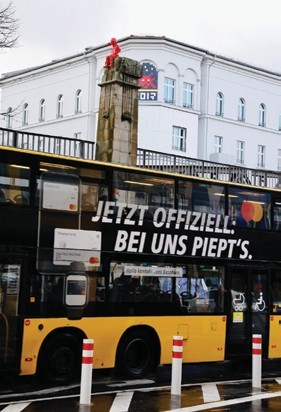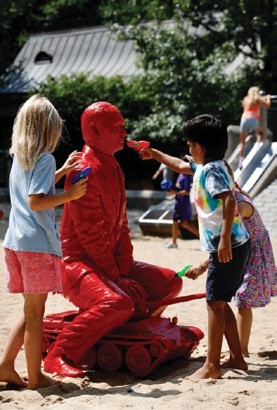Street Art has origins from a time we are yet to fathom and, in time, discover. Limited as we are by man-made language, nomenclature, and terminology besides the means so simplistic and apparent like paper and other media, like say walls, Art, in particular, Street Art, is an extension of what can be generated on medium but transgresses to public spaces.
On the European front, skewedly propagated as a world platform, it was in the French Revolution’s iconoclasm era, when rebels defaced high-end art to protest French society’s toxic hierarchy creating a niche called graffiti that became synonymous with vandalism. It was the waves of political and economic turbulence that triggered the rise of street art around the world: The Berlin Wall’s one-sided graffiti being projected as a fight of colourful expression on one side versus the stark totalitarianism of bland emptiness on the other being a rather simplistic definition.
So, French street artist James Colomina’s installation of Vladimir Putin in Central Park in early August 2022, five months after the Ukraine war started, was predictably bold in both its content and process. The artist who does not reveal himself because most of his installations “are unauthorised,” is “already facing problems with the authorities.” Ironically the installation, bold as it was, appeared in New York City of the United States of America where, according to a recent Data USA study, 85.4 per cent of archivists, curators, and museum technicians were White and the next most common ethnicity (Hispanic White) clocked in at a mere five per cent.
The statistics conveniently exclude those who do not “fit in” with them. Technically, and those valued, artists are predominantly White men, with 85.4 per cent of works in all major US museums belonging to White artists, 87.4 per cent by men. The diversity is not much greater for museums that specialise in modern art. At the Museum of Modern Art in New York City, for example, only 11 per cent of the artists in the collection are female, 10 per cent are Asian, and two per cent are black or African-American. At the San Francisco Museum of Modern Art, 18 per cent of the artists are female, seven per cent Asian, and two per cent black or African-American.
Wealthy patrons decide merit of art
It is the acute dearth of public funding owing to which museums and galleries are forced to rely on the wealthy patrons sitting on their executive boards to influence what art is “worthy” for public display. In October 2019, a New York Times analysis revealed that 40 per cent of museum trustees are Wall Street tycoons revealing that control on high-end art world isn’t merely determined by if a trustee is wealthy, but also where they derive their wealth from.
Street Art is different. And what makes Street Art this way is its ability to steer clear of political influence and economic compulsions. What binds Street Art and its proponents across the world is the ‘unauthorised’ nature of its existence and perpetration derived from swimming against the current. James Colomina’s installations are a case in point. And, James is clear with his modus operandi. “I’m not really afraid of the authorities. It’s a bit of a cat-and-mouse game. You must not get caught otherwise the installation is ruined,” he says gleefully.
James’ last installation in Berlin where he installed a little girl going over the wall and another sculpture above the railway caused quite a flurry. The authorities had to close the tracks for two hours to remove the sculpture.
“Why, even train-drivers slowed down as they approached the sculpture. They thought she was a real child,” he says. Another facet of Street Art is that it must not always be liked or be popular. “A lot of people don’t like me, but that’s okay. It’s even so much the better it would bother me to please everyone. I try to tell the truth with my sculptures and sometimes it hurts,” he says.
Art can be politically incorrect, and hurt too
Much on the lines of James’ installation in New York City’s Central Park, a thousand odd miles away in South Minneapolis, the Cup Foods convenience store, where a 911 call led to George Floyd’s police killing, today stands decorated with memorial art. This one, as opposed to Putin’s, for sure, is not as popular.
Local illustrator, muralist and teacher Melodee Strong created ‘Mama’ after George Floyd’s dying plea, depicting grieving black mothers, against a backdrop of the US flag. “I am a mother, and when George cried out for his ‘mama’ as he was taking his last breaths, I also cried,” felt strong adding, “That’s what we do when we are in trouble or scared, we cry out for God or our mothers. My son has been harassed and mistreated by the police. I have witnessed numerous times how the people I love have been abused by police. The anguish we feel from the fear and the experiences of those too many incidences is what I feel in the faces I painted… Even though this piece is about George Floyd, it’s more a dedication to all the mothers who have lost their child to police violence.”
Predictably, following Black Lives Matter protests erupting in cities, large corporations all around the country responded by nailing plywood across their doors and massive windows. Political graffiti, as critical intervention in urban space, is faced with legislative opposition as municipalities and police attempt to shut down the streets and the protests therein. Yet, even after protests disperse, it’s the Street Art in the form of graffiti that stands tall as a testament to the protestors’ collective voice. It is, today through social media that belongs to the masses instead of selective and controlled fora, documented and becoming a part of history.
Calling Macron’s bluff, through art
Like the time when French President Macron was elected, he made loud proclamations that there would be no more homeless people but, as usual, it was far from being true. “It was even worse, so I put him in a tent with homeless people,” says Colomina. “Why, the homeless were delighted with the move. The site stands on the edge of the Saint-Martin canal in Paris. At first, I asked some homeless people if they would welcome President Macron with them in a tent. They told me they were delighted; So for his birthday, I put him in a tent to shed some light on the homeless,” he added. “My intention was also to put the one who is at the very top of the pyramid, at the very bottom.”
It was in the 1970s, that graffiti artists in America successfully unionised for the first time. Between 1974 and 1980, over 20,000 artists and arts support staff secured full-time employment through CETA – making it the largest federally-funded arts project since the Works Progress Administration (WPA) created during the Great Depression, putting more than 8.5 million people to work. In New York City, the Cultural Council Foundation (CCF) launched the CETA Artists Project in 1978, with a budget of $4.5 million a year to fund the work of 300 artists, paying them $10,000 year plus benefits (nearly $46,000 today) to work directly with community organisations, on project teams, with performing companies, or on a wide array of public works.
Showcasing only a few for High-End World
Then, the wealthy responded by carefully choosing only certain graffiti artists to amplify and opened up the high-end art world selectively, incentivising street art for the sole purpose of earning money within the curated spaces set up by the elite. As a result, and inevitably, there was infighting and resentment that led to the unions eroding.
Today, the present-day continuation of excluding non-male and non-White artists from museums and the wealth associated with high-end art is no coincidence. The statistics highlight the high-brow art world as another example of the White and Wealthy very conveniently excluding those who do not “fit in” with them.


 James Colomina’s installation of Vladimir Putin in New York
James Colomina’s installation of Vladimir Putin in New York Gajanan Khergamker is an independent Editor, Solicitor and Film-maker. He is the founder of the International Think Tank DraftCraft.
Gajanan Khergamker is an independent Editor, Solicitor and Film-maker. He is the founder of the International Think Tank DraftCraft.